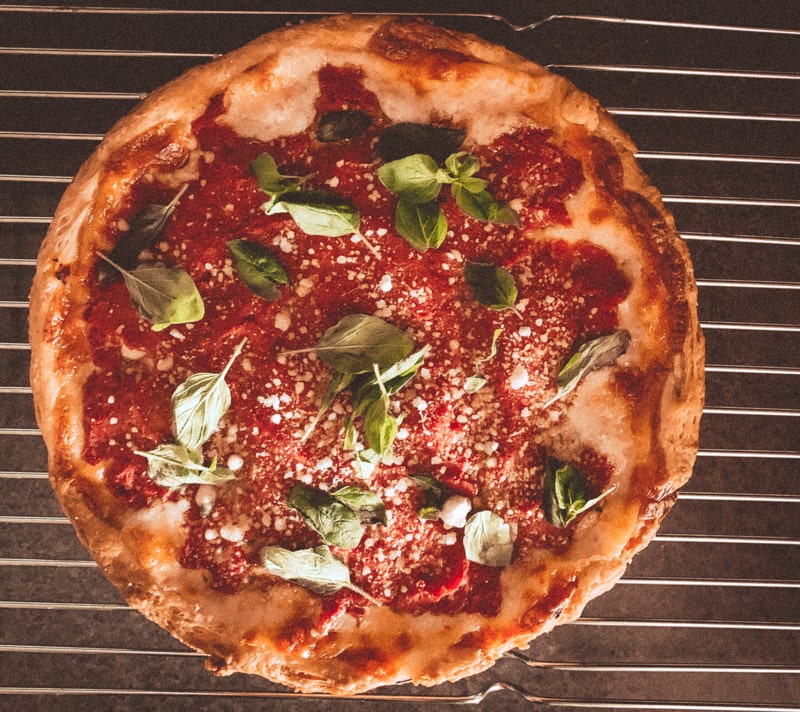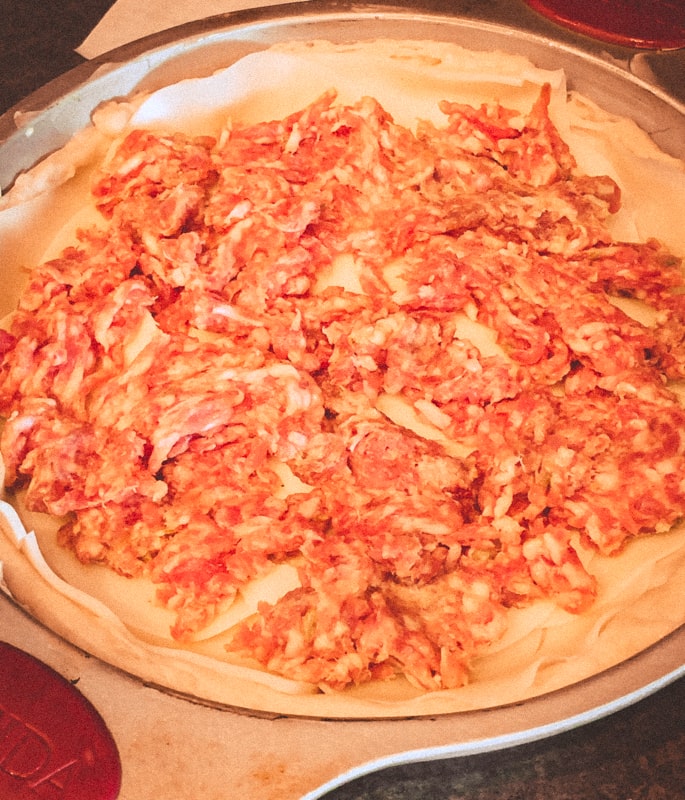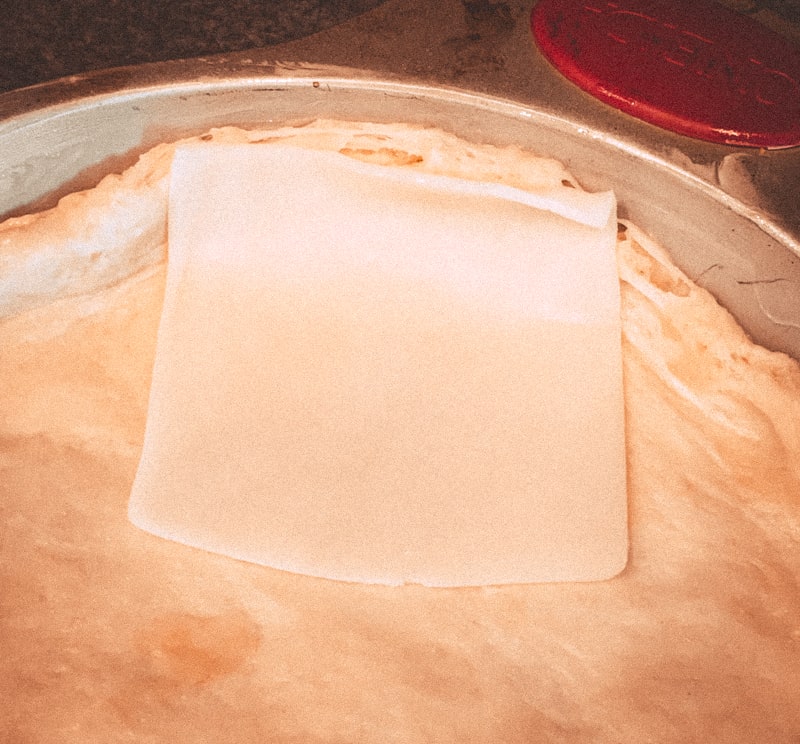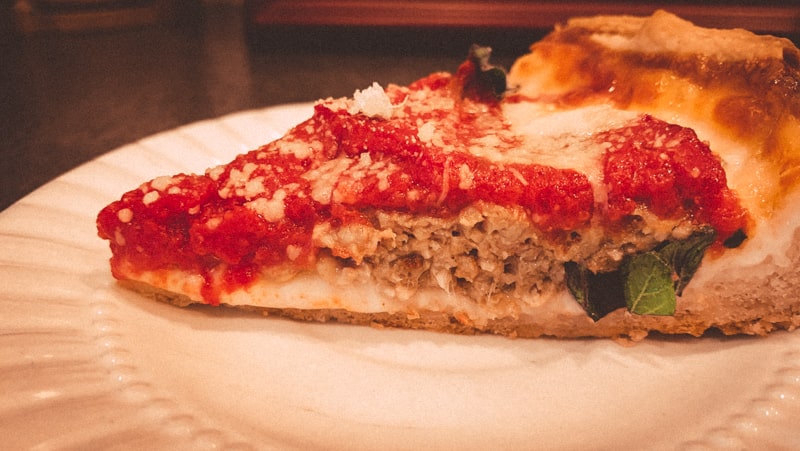Ratings, percentages, and more
rating: 9/8 slices

hydration: 46%

difficulty: not hard

Ingredient percents
| Ingredient | Standard % | Baker’s % |
| Flour (175g) | 55.68% | 94.59% |
| Semolina (10g) | 3.18% | 5.41% |
| Salt (0.5g)* | 0.16% | 0.27% |
| Sugar (1.04g)* | 0.33% | 0.56% |
| Yeast (0.75g)* | 0.24% | 0.40% |
| Water (85g) | 27.05% | 45.95% |
| Corn Oil (35g) | 11.13% | 18.92% |
| Olive Oil (7g) | 2.23% | 3.78% |
*The recipe calls for an 1/8 of a teaspoon of salt, a 1/4 teaspoon of sugar, and a 1/4 teaspoon of yeast. I measured all three by volume. For the chart, I pulled the yeast weight from King Arthur, the sugar from the Inch Calculator, and the salt weight from Epicurious.
The chart shows the standard ingredient percentages — how you’d normally calculate percentages — in the second column. For the standard percent, I added up all the ingredients and then divided that number by each individual ingredient and rounded to the second decimal (i.e. 175g flour / 314.29g total = 55.68%) The third column shows the “baker’s percentage,” which this post explains well.
A Little Background

As I’ve mentioned elsewhere on this blog, my mom made pizza frequently while I was growing up. I credit her for seeding my passion for pizza. After I left home, however, my dad started making Chicago-style pizza. It is good. Here, I’ll share how to make it. Unlike most posts, this one supplements instead of reviewing a recipe.
The Crust is Critical
The crust comes from pizzamaking.com, a site that has been around for a while and looks that way. Don’t let its appearance fool you. This site is a goldmine of pizza info. For a great Chicago-style pizza crust, follow this recipe (scroll down a bit for the process). Make sure to use a scale to weigh things out. Also, you can get superb results substituting corn oil or butter for Crisco in the pan and using regular all-purpose flour instead of the Ceresota AP.* Although, if you have both available, use them. I’ve tried it without the semolina and also tried substituting olive oil for the corn oil. I wouldn’t recommend those substitutions as the pizza won’t come out quite as good — less flaky and more dense.
*Ceresota AP is an all-purpose flour popular around Chicago.
Toppings (more like fillings)

Most pizzas, you can put pretty much anything on the top in whatever order you like and it will come out good, provided you’ve selected toppings with complimentary flavors. With Chicago-style pizza, the toppings and the way you add them matters. The linked to crust recipe doesn’t get into toppings. But not to worry, my dad perfected a recipe and amounts. I’ve played around with various tweaks but really think my dad’s method is the best. Here’s the technique, available exclusively on this site. : ) The amounts are for a single pizza, but I usually double it and make two pizzas.

- Put a rack in the middle of your oven and preheat to 425. Note: the recipe suggest using a pizza stone, but I’ve found putting the pan right on the rack works well.
- Spread out the dough in a 9-inch cake pan (non-stick is helpful) per the instructions in the recipe.
- Layer 4 ounces of thinly sliced low-moisture, whole-milk mozzarella, followed by 4 ounces of thinly sliced provolone. Notes: If you’re having trouble getting your crust to stay up the sides of the pan, push the cheese gently into the area where the dough starts going up the side of the pan. The cheese will help the crust stay in the sides of the pan. Also, you can substitute low-fat mozzarella for whole-milk but make sure it’s low-moisture. You don’t want to use fresh mozzarella here.
- Evenly spread 8 ounces of raw sausage over the cheese. Note: Yes, the sausage goes in raw. It cooks for almost 30 minutes at 450° F, but check the temperature after it comes out if you have concerns. You can use Italian sausage or breakfast. The bulk is easier to work with but you can also slice open the casing on preformed sausages and extract the sausage.
- Top the sausage with 14 ounces of well-drained crushed tomatoes. Notes: You really want to drain those tomatoes well. I often leave them to drain while waiting for the dough to rise. Moisture is the enemy of this crust. There are only a few ingredients here, so it’s worth getting good tomatoes. My favorite is Bianco DiNapoli Tomatoes. You don’t need to add salt or anything else to the tomatoes, the sausage provides plenty of flavor.
- Add any other toppings you want but don’t add anything with much moisture. I’ll say it again: moisture is the enemy of this crust. If you do add mushrooms, cook them first to extract the moisture. Personally, I don’t like anything other than the toppings listed above. It’s too easy to introduce moisture and the simple balance of flavors is hard to improve on anyway.
- Turn up the oven to 450°F, put in the pizza, and bake at 450°F for 28 minutes.
- Grate a little Pecorino or Parmesan over the top right after the pizza comes out.
- Wait 5 minutes and then remove the pizza from the pan and place it on a cooling rack for about 10 more minutes before serving. Note: The pizza should release pretty easily, especially if you used non-stick pans. Just be careful lifting it out to avoid breaking it.
Chicago-Style Pizza Departs from Other Styles

Some pizza varieties have subtle differences between them — a slightly thicker crust, a longer rise. Chicago-style pizza takes a major departure from any other pizza variety. The crust should be flaky and pie-like, about the thickness of a pie crust, and definitely thinner than the toppings (see photo above). However, the crust is much denser and crisp than standard crust and it shouldn’t have any issue supporting the heavy toppings. The rich crust, combined with the toppings lead to a much more filling pizza. I usually eat about half as many slices of Chicago-style than I do most other pizza styles. I love this pizza and hope you do to. If you’ve got ways to improve the technique listed here, let me know!
If you like pie, I highly recommend you try this delicious pizza pie.

One reply on “Chicago-Style Pizza at Home”
It’s delish!